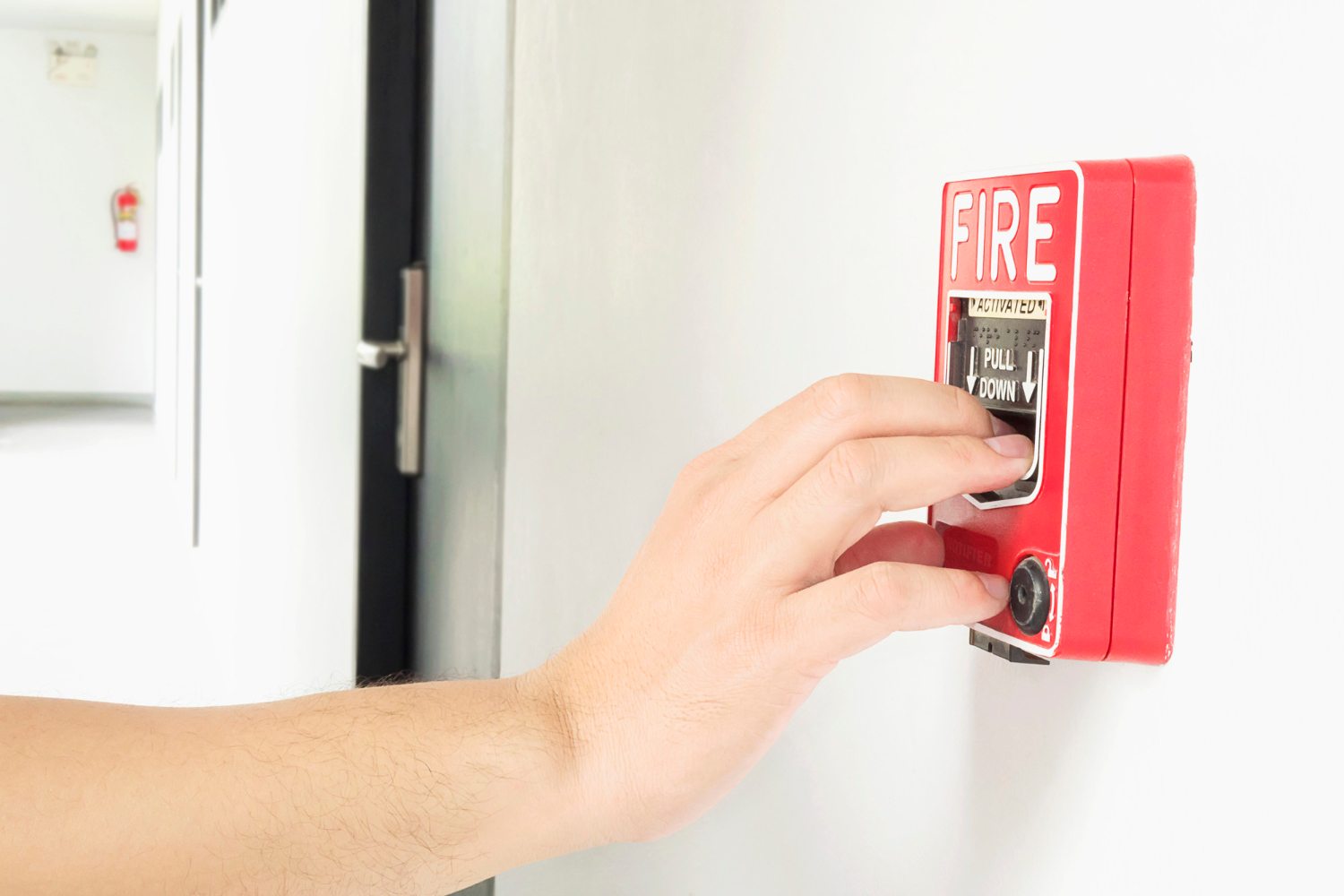Commercial security is evolving rapidly, with advanced technologies replacing older systems to prevent threats before they occur. Here are the five key trends shaping the industry today:
- AI Security Camera Systems: Over 90% detection accuracy, reducing false alarms by up to 75%.
- Remote Access Control Systems: Centralised, cloud-based management with 40-60% fewer incidents and lower maintenance costs.
- Advanced Fire Detection Networks: AI-powered systems cut false alarms by 90% and reduce property damage by 50%.
- Connected Security Devices: IoT integration improves response times by 40-60% and reduces theft by 30%.
- Data-Driven Security Planning: AI and analytics optimise patrols, cutting operational costs by 25%.
Quick Fact: The commercial security market is projected to reach $376.3 billion by 2028, driven by AI, cloud solutions, and predictive analytics.
These technologies work together to create smarter, scalable, and cost-effective security systems for businesses across industries.
1. AI Security Camera Systems
Current Technology Features
Modern AI cameras rely on advanced algorithms and localised data processing to identify threats with over 90% accuracy. This results in a 60-75% drop in false alarms compared to older systems.
Business Security Results
AI camera systems have shown clear improvements in key security metrics:
| Metric | Improvement |
|---|---|
| Detection Accuracy | Over 90% accuracy achieved |
| False Alarms | Reduced by 60-75% |
| Security Costs | Lowered by 30% |
| Response Time | 50% quicker |
These systems offer predictive capabilities that serve as a cornerstone for integrated security setups, which are explored further in this article.
Use Cases by Industry
- Retail: Helps prevent theft while providing insights into customer behavior.
- Transportation: Manages crowds effectively in busy transit hubs.
- Manufacturing: Monitors assets and ensures safety in real-time.
System Growth Options
With cloud-based dashboards and modular hardware, these systems can expand as needed. Many businesses see returns on their investment within 18 months, primarily through reduced losses.
This scalability also aligns well with remote access systems, which are covered in the following section.
The Impact of AI on Security Video Surveillance Systems
2. Remote Access Control Systems
Remote access systems, powered by AI’s predictive capabilities, now offer centralised control for managing threats more effectively.
Current Technology Features
Today’s remote access control systems have advanced significantly. They include cloud-based management, enhanced authentication methods, and real-time entry logging. A standout feature is heatmap visualisation, which helps security teams monitor movement patterns across facilities. Even when offline, these systems maintain their security functions.
Business Security Results
Adopting cloud-based access control systems has led to measurable improvements in security and efficiency:
| Metric | Improvement |
|---|---|
| Unauthorized Entry Incidents | 40-60% reduction, with 30% faster response times |
| Maintenance Costs | Dropped by 75% |
| System Management Time | Reduced by 40% |
These benefits align with the article’s focus on integrated solutions, allowing seamless coordination with surveillance and fire safety systems.
Use Cases by Industry
Different industries are leveraging these systems to meet specific needs. For example:
- Manufacturing: Controls access to hazardous areas to ensure safety.
- Retail: Manages security across multiple locations using unified systems.
Self-storage facilities have also embraced these systems. By using time-limited digital keys, they’ve simplified customer access while maintaining strong security measures.
System Growth Options
Thanks to cloud architecture, these systems can scale effortlessly across multiple locations through subscription models, eliminating the need for costly infrastructure upgrades. This scalability not only mirrors the flexibility of AI-powered camera systems but also sets the stage for integrating IoT devices.
When paired with fire detection networks, this centralised control becomes even more impactful, as explored in the next section.
3. Advanced Fire Detection Networks
Current Technology Features
Modern fire detection systems go beyond just sending alerts – they actively work to prevent disasters. Systems like SWIFT™ leverage wireless mesh networks and AI-powered filters to cut false alarms by 90% compared to older models. These smart systems can precisely identify threat locations and differentiate between regular heat changes and actual emergencies. Even during network outages, they stay operational, ensuring uninterrupted protection.
Business Security Results
Advanced fire detection networks have shown clear improvements in both safety and efficiency:
| Metric | Improvement |
|---|---|
| Property Damage | Up to 50% reduction |
| Injury Rates | Decreased by as much as 70% |
| Response Time | Containment is 53% faster (based on NFPA data) |
| Installation Costs | Labor costs cut by 40% with wireless systems |
When paired with IoT-enabled devices, these systems become even more effective – something we’ll explore further in the next section.
Use Cases by Industry
Various industries have tailored these systems to meet their unique needs:
- Education: Wireless systems in portable classrooms avoid the risk of asbestos exposure during installation.
- Hospitality: Heat detectors in commercial kitchens are designed to ignore typical cooking temperatures.
- Museums: Cultural institutions use discreet sensors that integrate with access controls to automatically seal off fire zones.
System Growth Options
Modern fire detection networks are built to scale, making them ideal for growing businesses. Integrating these systems into broader security setups improves their overall efficiency and simplifies management.
“The integration of predictive maintenance algorithms has revolutionised how we approach system reliability. By monitoring sensor degradation before failures occur, we’ve significantly reduced system downtime and maintenance costs”, highlights a recent industry analysis.
sbb-itb-6668fe6
4. Connected Security Devices
Modern fire detection networks have evolved into connected security ecosystems, thanks to IoT technology. These devices combine IoT integration, dual Wi-Fi/cellular connectivity, and edge computing to form smart, efficient networks. For instance, systems like Viso Suite can process video locally while ensuring coordination across the entire system.
These devices also integrate with security information and event management (SIEM) systems. By processing data locally using edge computing, they reduce bandwidth demands and ensure functionality even during network outages.
Business Security Results
Connected security systems have shown measurable improvements in key areas:
| Metric | Impact |
|---|---|
| Security Response | Response times improve by 40-60%, reducing theft by 30% |
Use Cases by Industry
Various industries use connected security devices to tackle specific challenges:
- Retail: Spot AI‘s smart cameras work with point-of-sale systems to identify checkout issues and prevent losses.
- Manufacturing: Continuous monitoring supports predictive maintenance, minimising equipment downtime.
- Self-Storage: Entry pattern heatmaps enhance security by identifying trends and vulnerabilities.
System Growth Options
Platforms like Spot AI allow businesses to expand their systems using existing hardware. Cloud-based dashboards make managing multiple locations simpler, enabling more effective, data-driven security strategies, which will be discussed further in the next section.
5. Data Analysis for Security Planning
Current Technology Features
Modern security strategies now utilise data from IoT-connected devices alongside advanced analysis systems. By combining AI and machine learning, these systems can process security data in real time. Features like keyword-based video searches and occupancy monitoring are now commonly available.
To ensure both speed and data protection, these platforms handle data locally before securely transmitting it to the cloud. By integrating data from multiple sources, they create a unified security ecosystem. This approach ties together the earlier phases of threat detection (Sections 1-4) with actionable responses.
Business Security Results
Planning security measures based on data has led to measurable improvements in key areas:
| Metric | Improvement |
|---|---|
| Threat Response Time | 30-50% faster |
| Operational Costs | 25% lower due to optimised patrols |
| Retail Shrinkage | 18% reduction, as seen in Amazon Go |
Use Cases by Industry
Retail businesses have seen benefits from combining customer movement heatmaps with loss prevention tools. This has resulted in a 35% drop in theft incidents.
“Walmart’s implementation reduced shoplifting by 35% and saved $200M annually through AI video analytics”
In logistics, advanced monitoring systems have enhanced warehouse security by enforcing strict protocols. AI-driven tools analyse traffic patterns and adjust security measures to address potential risks.
System Growth Options
Cloud-based platforms allow businesses to expand their analytics capabilities without overhauling existing infrastructure. Modular systems make it easy to add sensors as needed, while localised data processing ensures security. This flexibility lets organisations scale their security systems according to their budget and requirements.
Conclusion
AI surveillance, cloud-based controls, smart fire systems, IoT devices, and predictive analytics now work together to create security ecosystems designed to stop threats before they happen. These tools provide multiple layers of protection, focusing on prevention rather than just recording incidents.
The cost benefits are striking: cloud systems reduce ownership expenses by 35-50% compared to older setups, and AI automation cuts manual monitoring efforts by 70%. This improved efficiency benefits industries ranging from retail loss prevention to manufacturing safety.
The security field is advancing quickly. Experts predict breakthroughs by 2026, such as quantum encryption for access logs and better biometric-spoofing detection in AI-powered cameras. These improvements will make security systems even more effective against new threats.
As challenges grow more complex, these five technologies provide a strong, layered defense – from AI-driven threat detection to cloud-managed response coordination. The cloud’s flexibility allows businesses to scale their security without hardware restrictions, staying prepared for both current and future demands.
FAQs
What is the difference between cloud access control and on-prem?
The choice between cloud-based and on-premises access control systems shapes how businesses set up their security frameworks.
Here’s a quick comparison:
| Feature | Cloud-Based Access Control | On-Premises Access Control |
|---|---|---|
| Data Storage | Stored on remote, secure servers | Stored on local, physical servers |
| Initial Investment | Lower upfront costs | Higher hardware expenses |
| Maintenance | Managed by the provider | Requires in-house IT management |
| Scalability | Easily adjustable to needs | Limited by physical hardware capacity |
Cloud systems are often more budget-friendly for businesses with multiple locations. For example, ButterflyMX reports that these systems can reduce 3-year costs by 40%, thanks to the elimination of server expenses and easier management.s
When deciding between cloud and on-premises options, think about:
- The reliability of your internet connection
- How well the system integrates with your current AI surveillance or IoT setup (see Sections 1-4)
- Your ability to handle ongoing maintenance
- Future growth plans
- Whether your budget leans toward operational expenses (OpEx) or capital expenses (CapEx)



